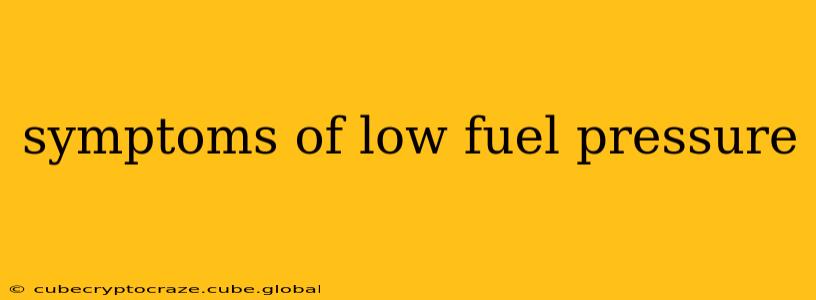Low fuel pressure can significantly impact your vehicle's performance and, if left unaddressed, can lead to serious engine damage. Understanding the symptoms is crucial for early detection and preventing costly repairs. This comprehensive guide will explore the common signs of low fuel pressure, helping you identify the problem and get your vehicle to a mechanic promptly.
What Causes Low Fuel Pressure?
Before diving into the symptoms, it's helpful to understand what might cause low fuel pressure in the first place. Several factors can contribute:
- Clogged Fuel Filter: A dirty fuel filter restricts fuel flow, reducing pressure.
- Faulty Fuel Pump: A malfunctioning fuel pump can't deliver sufficient fuel pressure. This is a common culprit.
- Leaking Fuel Lines or Injectors: Leaks in the fuel system allow fuel to escape, lowering the pressure.
- Clogged Fuel Injectors: Blocked injectors hinder fuel delivery, leading to reduced pressure.
- Problems with the Fuel Pressure Regulator: This component controls fuel pressure; a malfunction can cause either too high or too low pressure.
- Weak Fuel Pump Relay: The relay controls the power to the fuel pump; a faulty relay prevents the pump from working correctly.
Common Symptoms of Low Fuel Pressure
Now let's examine the telltale signs indicating low fuel pressure in your vehicle:
1. Engine Hesitation or Stuttering:
This is often one of the first noticeable symptoms. The engine may hesitate or stumble when accelerating, especially under load. This occurs because the engine isn't receiving enough fuel to maintain smooth operation.
2. Engine Misfires:
Low fuel pressure can lead to engine misfires, causing rough running, decreased performance, and potentially damaging the catalytic converter. Misfires are often accompanied by a check engine light.
3. Reduced Engine Power:
A lack of sufficient fuel will severely limit engine power. You may notice difficulty accelerating, sluggish performance, and a significant reduction in overall power output.
4. Difficulty Starting:
While not always the case, low fuel pressure can make it hard to start the engine. The engine may crank but fail to start or take longer than usual to ignite.
5. Poor Fuel Economy:
Lower fuel pressure can result in decreased fuel efficiency as the engine works harder to compensate for the insufficient fuel supply. You may notice a drop in your vehicle's miles per gallon (MPG).
6. Check Engine Light:
The check engine light is a crucial indicator, often illuminating when there are problems within the fuel system, including low fuel pressure. A diagnostic scan from a mechanic can identify the precise cause.
7. Engine Surging:
In some cases, you might experience engine surging – sudden increases and decreases in engine speed. This erratic behavior is often linked to inconsistent fuel delivery due to low pressure.
What to Do If You Suspect Low Fuel Pressure
If you experience any of these symptoms, it's vital to address the issue immediately. Continuing to drive with low fuel pressure can cause significant engine damage. Here's what you should do:
- Check the fuel gauge: Make sure you're not simply running low on fuel.
- Consult your vehicle's owner's manual: It might provide specific information on diagnosing fuel system issues.
- Visit a qualified mechanic: A professional mechanic can diagnose the problem accurately and perform the necessary repairs, such as replacing a faulty fuel pump, fuel filter, or fixing a leak. Delaying repairs can lead to more extensive and expensive damage.
This information is for general guidance only and does not constitute professional automotive advice. Always consult a qualified mechanic for diagnosis and repair of vehicle problems.
